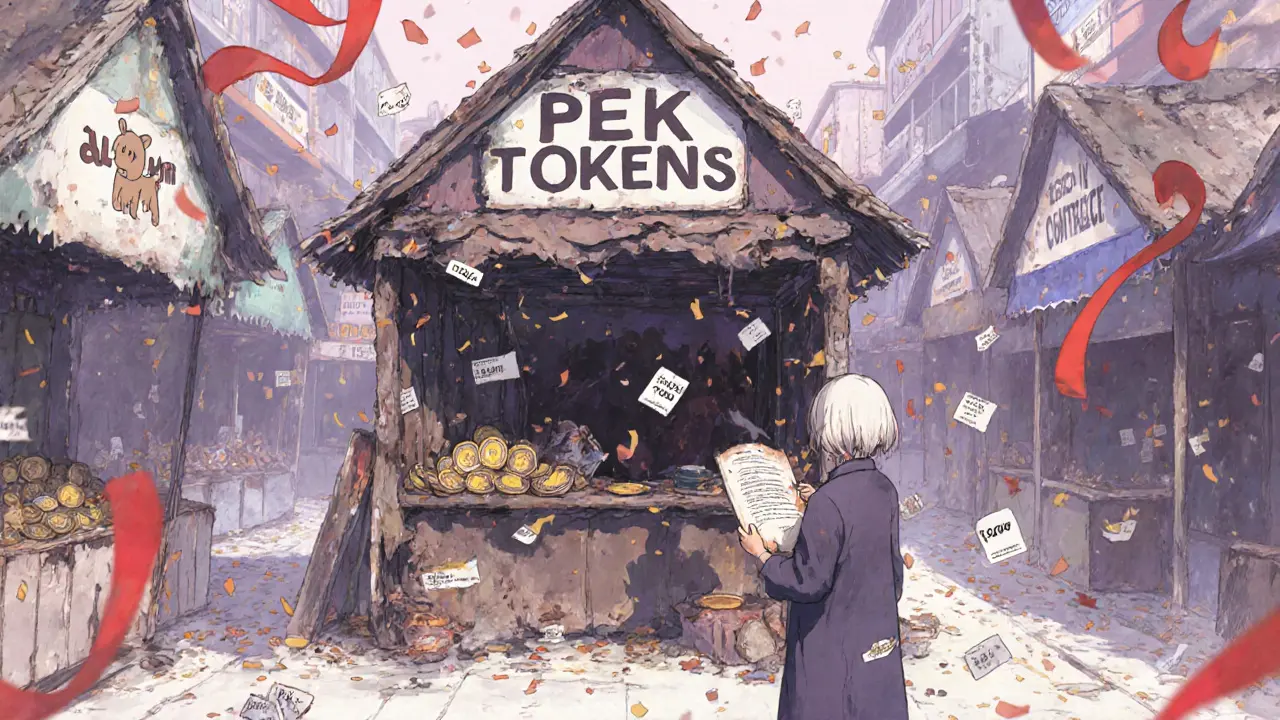What is Pek (PEK) crypto coin? The truth about this obscure meme token

PEK Token Validator
There’s a crypto token called Pek (PEK) floating around - and if you’ve seen it on a price tracker, you might be wondering if it’s worth your time. The short answer? Probably not. But here’s what you actually need to know before you even think about buying it.
What is Pek (PEK)?
Pek (PEK) is an Ethereum-based meme token tied to an obscure internet subculture called "Kekism." It’s not about dogs, money, or technology - it’s about a meme. Kekism started as a joke within 4chan forums, mixing Egyptian mythology (the god Kek) with Pepe the Frog. Pek (PEK) was created to ride that wave, positioning itself as the "messenger" of this digital cult. It has no real use case. No team. No product. Just a token name, a contract address, and a story built on internet absurdity.
The token has a fixed supply of 1 billion PEK. That’s a lot of coins - but with a price around $0.000014 in late 2023, that only adds up to a market cap of roughly $15,200. For comparison, Dogecoin had a market cap of over $11 billion at the same time. Pek isn’t competing with the big players. It’s barely on the radar.
The contract and supply details
Pek runs on Ethereum as an ERC-20 token. Its smart contract address is 0x77781231850881cf48E6701Ba9197fb954AF1567 the official Ethereum contract address for the Pek (PEK) token. It has a 0% transaction tax, which sounds great - no extra fees when you buy or sell. But here’s the catch: there’s almost no one trading it.
According to Blockspot.io, the liquidity pool for Pek was "burnt." That means the developers removed the funds meant to keep the token tradable on decentralized exchanges. On paper, this prevents a rug pull - the scam where creators drain the liquidity and vanish. But in practice, it also means no one can easily buy or sell PEK. There’s no pool to trade against. If you want to sell, you need to find someone willing to buy - and there are almost no buyers.
Why trading PEK is nearly impossible
In late 2023, the 24-hour trading volume for Pek was $107. That’s less than what you’d spend on a coffee in Wellington. Low volume means two things: price manipulation and zero liquidity.
- You can’t buy a large amount without pushing the price way up.
- You can’t sell without crashing it.
The price swings were wild - a 6.9% daily move was normal. One day it traded at $0.0000144, the next at $0.0000154. That’s not volatility from demand - it’s from a handful of people moving tiny amounts. And the token has lost 94.3% of its all-time high of $0.000267. If you bought at the peak, you’d be down to about 6 cents on the dollar.

The big problem: confusion with other "PEK" tokens
Here’s where it gets dangerous. CoinMarketCap lists another token called Pekingese (PEK) - yes, the dog breed. It’s a completely different project with a different contract address (0x8249207da5…), a supply of only 10 million tokens, and a theme based on cute dogs, not internet memes. It even claims to have "locked liquidity," which Pek doesn’t.
Then there’s Pekpek (PEKPEK) on Ethereum and another PEK token on Solana. All of them use the same ticker. All of them are separate. All of them are low-cap meme coins with no real following.
If you’re not careful, you could think you’re buying the meme token - and end up with the dog coin. Or worse, you could send funds to the wrong contract and lose your money forever. There’s no customer service. No support. No way to reverse it.
No community. No development. No future.
Pek’s whitepaper (if you can even call it that) promises "influencer marketing," "partnerships with Uniswap and MetaMask," and "integration with Binance and Coinbase." None of that happened. As of late 2023, there were no exchange listings. No social media buzz. No Discord server with more than 50 people. No Reddit threads. No YouTube videos explaining the project.
Compare that to Dogecoin - which had Elon Musk tweeting about it, major exchanges listing it, and a global community that still trades it daily. Pek has none of that. It’s a ghost town.
Even the people who created it seem to have vanished. No GitHub repo. No team bios. No Twitter account linked to the project. The only source of info is Blockspot.io - a small crypto data site with no reputation for deep analysis. That’s not a red flag. That’s a whole warning sign flashing in neon.
Should you buy Pek (PEK)?
No.
Not because it’s a scam - though it might be. Not because it’s illegal - it’s not. But because it’s a dead asset. You’re not investing in a project. You’re gambling on the last few people still holding it, hoping they’ll sell to you at a slightly higher price. And even if you win that game, you’ll be stuck with a token you can’t easily cash out.
There’s no utility. No roadmap. No team. No liquidity. No community. And the market has already spoken: it’s worth less than $16,000 total.
If you’re looking for meme coins, stick with the ones that have real volume, real exchanges, and real people talking about them. Pek isn’t one of them. It’s a footnote in crypto history - a quiet, forgotten experiment that never caught fire.

What happened to its all-time high?
Pek hit its peak at $0.000267 in early 2023. That’s when meme coin hype was at its craziest. But the price collapsed fast. Why? Because hype without substance always fades. There was no reason for the price to stay up. No adoption. No use. No reason to hold it.
Now, it trades at about 94% below that high. That’s not a correction. That’s a collapse. And it’s not coming back.
How to avoid similar tokens
- Check the contract address - never rely on the ticker alone.
- Look for liquidity on Uniswap or PancakeSwap. If it’s burnt or locked with no public info, walk away.
- Search for social media. If there’s no Twitter, Discord, or Telegram, it’s likely abandoned.
- Check CoinGecko or CoinMarketCap for trading volume. Anything under $1,000/day is a red flag.
- Don’t trust whitepapers that sound like marketing fluff. If it says "revolutionary" or "next-gen," it’s probably empty.
There are hundreds of these tokens. Most die within weeks. A few become memes. Almost none become investments.
Is Pek (PEK) a scam?
It’s not confirmed as a scam, but it has all the signs of an abandoned project. The liquidity was burnt, there’s no team, no community, and no exchange listings. That’s not how legitimate projects operate. It’s more likely a failed experiment than an active scam.
Can I trade Pek (PEK) on Binance or Coinbase?
No. Pek (PEK) is not listed on any major exchange, including Binance or Coinbase. It only trades on decentralized platforms like Uniswap, and even there, volume is so low that trading is nearly impossible without moving the price.
What’s the difference between Pek (PEK) and Pekingese (PEK)?
They’re completely different tokens with the same ticker. Pek (PEK) is tied to the Kek meme culture and has a 1 billion supply. Pekingese (PEK) is based on the dog breed, has only 10 million tokens, and a different contract address. Mixing them up could cost you money.
Why does Pek have a 0% transaction tax?
A 0% tax sounds good - no fees when buying or selling. But since there’s almost no trading activity, the tax rate doesn’t matter. The real issue is lack of liquidity. Even with zero fees, you can’t easily sell your tokens because no one is buying.
Is Pek (PEK) worth investing in?
No. With a market cap under $20,000, zero trading volume, no community, and no development, Pek (PEK) offers no realistic chance of return. It’s a speculative gamble with near-zero odds of success. Save your money for projects with real traction.
Final thoughts
Pek (PEK) isn’t a crypto project. It’s a digital artifact - a relic of a meme that never went mainstream. It’s like finding a VHS tape of a viral YouTube video from 2008. It existed. It had a moment. But no one’s watching it anymore.
If you’re curious, you can buy a few tokens for fun. But treat it like a novelty item - not an investment. Don’t put in money you can’t afford to lose. And never, ever confuse it with Pekingese (PEK) or any other token with the same ticker.
The crypto space is full of noise. Pek (PEK) is just one of the quietest signals - the kind that fades before anyone even notices it’s there.








Louise Watson
November 6, 2025 AT 23:47Benjamin Jackson
November 8, 2025 AT 12:03Liam Workman
November 8, 2025 AT 22:29Cydney Proctor
November 9, 2025 AT 19:15Kevin Mann
November 9, 2025 AT 21:50Grace Huegel
November 10, 2025 AT 17:31Sarah Scheerlinck
November 11, 2025 AT 19:27Jacque Hustead
November 12, 2025 AT 10:57Robert Bailey
November 13, 2025 AT 06:08Natalie Nanee
November 14, 2025 AT 10:44Meagan Wristen
November 14, 2025 AT 11:00Becca Robins
November 14, 2025 AT 17:11Alexa Huffman
November 16, 2025 AT 16:02Steven Lam
November 18, 2025 AT 02:00Finn McGinty
November 18, 2025 AT 21:59Benjamin Jackson
November 19, 2025 AT 00:07